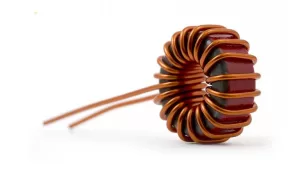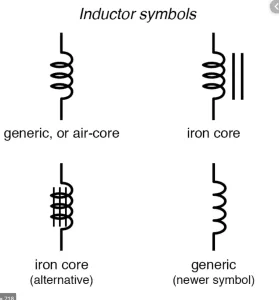
The Indispensable Inductor: The Unsung Heroes of Circuits
December 15 2023  1358
1358
Inquiry
Global electronic component supplier AMPHEO PTY LTD: Rich inventory for one-stop shopping. Inquire easily, and receive fast, customized solutions and quotes.
QUICK RFQ
ADD TO RFQ LIST
In this blog, we will delve into the world of inductors, exploring their significance, applications, types, and inner workings.
What is an Inductor?
An inductor is a passive electronic part that, when an electric current passes through it, stores energy in a magnetic field. Usually, it is made up of a wire coil wound around a core. An inductor's primary characteristic is its resistance to current fluctuations, which makes it a crucial component in the regulation and management of electrical circuits.
Inductor Symbol

Are Inductors polarized?
No, inductors are not polarized components. Unlike capacitors and diodes, inductors do not have a specific polarity and can be connected in either direction in a circuit.Types of Inductor
- Air core inductors: A coil is wound around a non-magnetic material, like ceramic or plastic, to create an air core inductor.
- Iron core inductors: Usually composed of iron or ferrite, these inductors have a coil wound around a ferromagnetic core.
- Toroidal inductors: These produce minimal electromagnetic interference by winding a coil around a donut-shaped core.
- SMD (Surface Mount Device) inductors: These are available in a range of sizes and shapes and are intended for use in surface mount applications.
- Coupled inductors: These are made up of two or more inductors connected by a magnetic field.
Can an Inductor Store Energy?
Energy can be stored in inductors using their magnetic fields. Inductors are useful for energy transfer and storage in a variety of electronic systems because they can release the stored energy back into the circuit when the current changes.Video related to Inductor
How Inductor Works?
The basis for an inductor's operation is electromagnetic induction. A conductor creates a magnetic field surrounding it when an electric current passes through it. Faraday's law of electromagnetic induction states that when the current changes, the magnetic field changes as well, inducing a voltage in the conductor. When current passes through the coil of wire in an inductor, a magnetic field is produced. Magnetic flux, which is stored energy, is produced by this magnetic field. Lenz's law states that when the inductor's current changes, the magnetic field must also change. This results in an opposite voltage across the inductor to the current change. Because of their ability to resist fluctuations in current, inductors are employed in circuits to store energy, filter out specific frequencies, and regulate the flow of current. An inductor's primary function is to resist variations in current flow, and many different electronic applications make use of this characteristic.How does an inductor store energy?
A magnetic field is the form that energy is stored in an inductor. An inductor's coil generates a magnetic field when current passes through it. Energy is stored in this magnetic field. The magnetic field's potential energy is where the energy is stored. A voltage is induced across the inductor as a result of changes in the magnetic field brought about by variations in the current flowing through the inductor. Lenz's law states that this induced voltage is in opposition to the change in current. Consequently, the inductor efficiently stores energy in the magnetic field by resisting variations in current flow. The magnetic field collapses when the current flowing through the inductor drops, redistributing the stored energy as electrical energy back into the circuit. Inductors are helpful in many electronic applications, including energy storage, filtering, and regulating current flow in circuits, due to their ability to store and release energy in the form of a magnetic field.Inductor vs Capacitor
Energy Storage:- Inductor: When current passes through an inductor, the magnetic field it creates stores energy. More energy is stored and a stronger magnetic field results from increased current.
- Capacitor: When there is a voltage differential between the plates of a capacitor, an electric field is created that stores energy. More energy is stored and the electric field is stronger the greater the voltage differential.
- Inductor: With an inductor, high-frequency AC signals can be blocked more successfully since the rapidly fluctuating current creates stronger opposing voltages. It makes it easy for low-frequency AC signals to pass through.
- Capacitor: Because the voltage differential across its plates changes gradually, it is more effective at blocking low-frequency AC signals. It makes it easy for high-frequency AC signals to flow through.
- Inductor: Most inductors are not polarized. Its operation is unaffected by the direction in which you connect it to a circuit.
- Capacitor: The majority of types require that the proper positive and negative terminals be connected to the circuit because they are polarized. The capacitor may be harmed by connecting in the wrong way.
- Inductor: Used in power converters to convert AC to DC or vice versa, transformers to adjust voltage levels, and filters to block undesirable frequencies.
- Capacitor: Used in coupling circuits to join various parts of a circuit without altering their DC components, timing circuits to create delays, and filters to block undesirable frequencies.
Where Inductor is used?
- Filtering: Inductors and capacitors work together to provide filters that let through some electrical signal frequencies while rejecting others.
- Power Supplies: To store energy and even out the output voltage, power supply circuits employ inductors.
- Signal processing: Inductors are used to tune and filter signals in radio frequency (RF) circuits, audio equipment, and telecommunications devices.
- Motors and Transformers: Electric motors and transformers rely heavily on inductors, which are essential parts that regulate and transmit electrical energy.
- Oscillators and Timing Circuits: Inductors and capacitors work together to produce oscillators and timing circuits in electronic devices.
Conclusion
In conclusion, inductors are undoubtedly the unsung heroes of circuits because they are essential to the operation of electronic systems and devices. Because of their energy-storage capacity and influence on high-frequency circuit behavior, inductors are essential parts of contemporary electronics. Engineers and enthusiasts can use inductors to create dependable and efficient electronic systems by learning about their types, applications, and symbols.FAQs about Inductor
Are inductors polarized? No, inductors are not polarized and can be connected in either direction without affecting their function. Can an inductor store energy? Yes, as discussed earlier, inductors can store energy in the form of a magnetic field. What happens to an inductor at high frequency? An inductor's increased impedance at high frequencies restricts the amount of current that can flow through it. They can be effectively used in circuits to filter out high-frequency noise due to this property.Populer Posts
EP4CGX15BF14C8
Intel
EP4CE6F17C7N
Intel
EP4CE22E22C8N
Intel
5SGSMD4K2F40I2LG
Intel
EP2C8F256I8N
Intel
AGL250V5-FGG144
Microchip Technology
5CGXBC3B6F23C7N
Intel
OR2C12A3M84I-D
Lattice Semiconductor Corporation
EP1AGX20CF484I6
Intel
EP2C20F484I8
Intel
1SG250HN3F43E2VG
Intel
